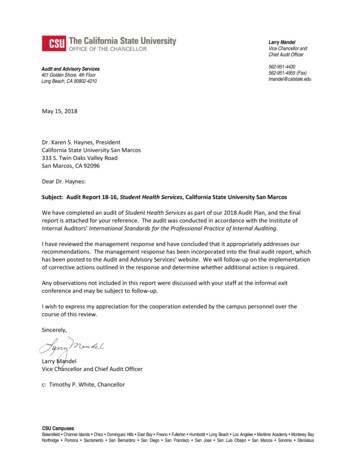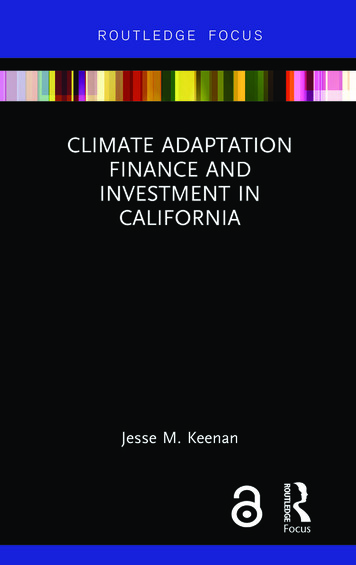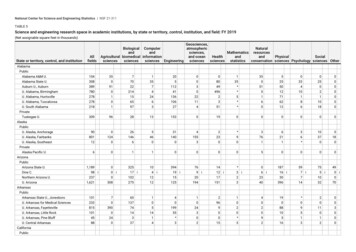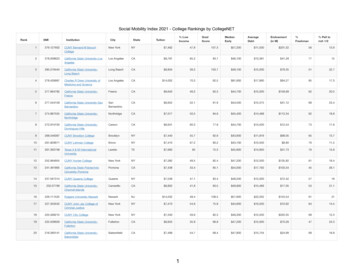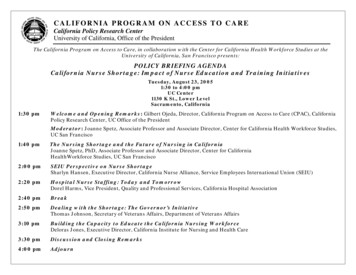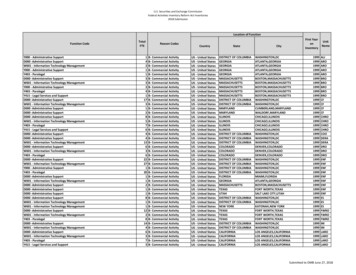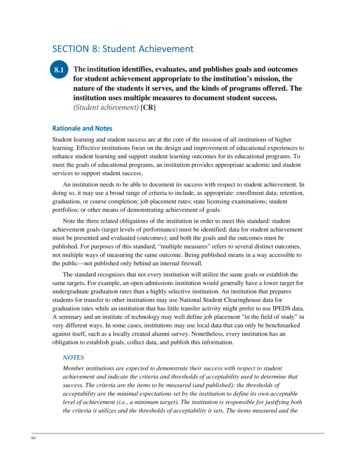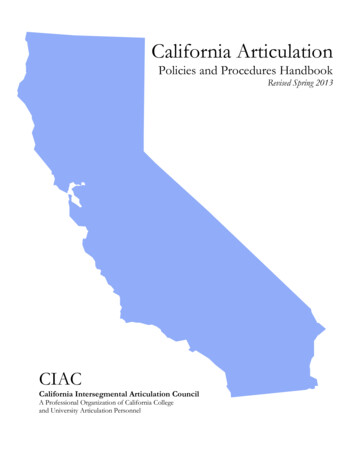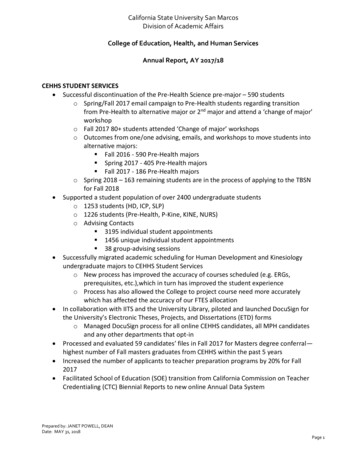
Transcription
California State University San MarcosDivision of Academic AffairsCollege of Education, Health, and Human ServicesAnnual Report, AY 2017/18CEHHS STUDENT SERVICES Successful discontinuation of the Pre-Health Science pre-major – 590 studentso Spring/Fall 2017 email campaign to Pre-Health students regarding transitionfrom Pre-Health to alternative major or 2nd major and attend a ‘change of major’workshopo Fall 2017 80 students attended ‘Change of major’ workshopso Outcomes from one/one advising, emails, and workshops to move students intoalternative majors: Fall 2016 - 590 Pre-Health majors Spring 2017 - 405 Pre-Health majors Fall 2017 - 186 Pre-Health majorso Spring 2018 – 163 remaining students are in the process of applying to the TBSNfor Fall 2018 Supported a student population of over 2400 undergraduate studentso 1253 students (HD, ICP, SLP)o 1226 students (Pre-Health, P-Kine, KINE, NURS)o Advising Contacts 3195 individual student appointments 1456 unique individual student appointments 38 group-advising sessions Successfully migrated academic scheduling for Human Development and Kinesiologyundergraduate majors to CEHHS Student Serviceso New process has improved the accuracy of courses scheduled (e.g. ERGs,prerequisites, etc.),which in turn has improved the student experienceo Process has also allowed the College to project course need more accuratelywhich has affected the accuracy of our FTES allocation In collaboration with IITS and the University Library, piloted and launched DocuSign forthe University’s Electronic Theses, Projects, and Dissertations (ETD) formso Managed DocuSign process for all online CEHHS candidates, all MPH candidatesand any other departments that opt-in Processed and evaluated 59 candidates’ files in Fall 2017 for Masters degree conferral—highest number of Fall masters graduates from CEHHS within the past 5 years Increased the number of applicants to teacher preparation programs by 20% for Fall2017 Facilitated School of Education (SOE) transition from California Commission on TeacherCredentialing (CTC) Biennial Reports to new online Annual Data SystemPrepared by: JANET POWELL, DEANDate: MAY 31, 2018Page 1
California State University San MarcosDivision of Academic AffairsCollege of Education, Health, and Human ServicesAnnual Report, AY 2017/18HUMAN DEVELOPMENT DEPARTMENT Dr. Teru Toyokawa started as Department Chair in August 2017. The Department hired a tenure-track faculty position (Child Development Position) HD faculty continued to work collaboratively with Kinesiology on Fall Prevention andInjury Recovery Project. HD faculty continued to work collaboratively with COBA providing HD students withopportunities to work with CoBA students through three Senior Projects. HD faculty worked with National Latino Research Center to support Latino/a studentsacademically and socially on the CSUSM campus. HD faculty worked with CoBA, local high schools, and Extended Learning to makesignificant progress in implementing Youth University Mentorship and Food CulinarySkills Training Program. HD students engaged in eight projects through participating in Democracy in Action (acommunity engagement practice through which CSUSM faculty and students partnerwith a local city government). The HD Student Poster Presentation Session was held in spring. Approximately 23posters from HD courses and professional conference presentations in the past werepresented. One HD senior student won the best undergraduate poster presentation award at theNorthwest Conference of Family Relations Conference. In total 67 HD Club members contributed to CSUSM and local communities throughvolunteering at 6 events (e.g., San Diego Food Bank, Carlsbad 5000, Cesar Chavez Day ofService), spending approximately 250 hours on volunteer work. HD students and faculty organized a support group for HD students who are parents toprovide an opportunity for parent students to share their experiences and challenges.Eight students and six faculty members attended the group meeting.KINESIOLOGY DEPARTMENT The department successfully launched the new Accelerated BS in Kinesiology programthrough Extended Learning. The department doubled enrollment in the Temecula BS Kinesiology program. The department graduated the first cohort of Kinesiology MS students with a 100%completion rate. CSUSM faculty developed a new Virtual Reality laboratory to be used for research andinstruction. The department hosted guest speaker Dr. Sara Ostadabbas to help launch new VR lab. The department implemented revised KINE curriculum and major options in Fall 2017.Prepared by: JANET POWELL, DEANDate: MAY 31, 2018Page 2
California State University San MarcosDivision of Academic AffairsCollege of Education, Health, and Human ServicesAnnual Report, AY 2017/18 Kinesiology faculty served on conference planning committees for a national statisticsconference.Kinesiology faculty member received the CEHHS Service Leadership AwardKinesiology faculty member served as external review for WASC accreditation of theKinesiology Department at the University of St. Katherine in San Marcos.Kinesiology faculty member organized the 2018 Kick Toxic Butts off Campus (4,056 buttscollected with 64 student/staff volunteers).Kinesiology faculty have mentored four undergraduate students through the FacultyMentoring Program.Kinesiology faculty, together with the Office of Internships, provided oversite ofapproximately 200 undergraduate student interns totaling 18,000 volunteer hours.Kinesiology faculty established new community research partnerships with Rock SteadyBoxing, High Tech High, and Oceanside Police Department.Kinesiology faculty served on grant review panels for National Science Foundation andDepartment of Defense.Kinesiology faculty received a total of 30k in internal funding, with another 13k stillunder review.Kinesiology faculty received a total of 45k in external funding.Kinesiology faculty submitted six proposals for external funding to the NIH and the KeckFoundation for a total of 1.8mil.Kinesiology faculty published 23 peer reviewed journal articles, with another eightcurrently under review. Most publications include at least one undergraduate studentas a co-author.Kinesiology faculty presented 17 research abstracts at national conferences. Mostabstracts include at least one undergraduate or graduate student as a co-author.Two CSUSM Kinesiology students participated in the undergraduate student researchcompetition at the annual meeting of the Southwest chapter of the American College ofSports Medicine.PUBLIC HEALTH DEPARTMENT A new tenure-track faculty was added - Dr. Asherlev Santos was hired as AssistantProfessor for Global Health in Fall 2017. A total of 31 and 8 students were admitted, matriculated, and participated inorientation for Fall 2017 and Spring 2018 semesters (Cohorts 3 & 4), respectively. A total of 37 MPH students from Fall 2016 and Spring 2017 cohorts graduated and wereawarded their diplomas during the CSUSM’s Spring 2018 Commencement Ceremony. Innaugural MPH Graduation & Awards Ceremony was held on 12/14/17 (Fall 2016Cohort) and a second ceremony was held on 5/16/18 (Spring 2017 Cohort).Prepared by: JANET POWELL, DEANDate: MAY 31, 2018Page 3
California State University San MarcosDivision of Academic AffairsCollege of Education, Health, and Human ServicesAnnual Report, AY 2017/18 Five (5) MPH students (in collaboration with students from the School of Nursing)participated in the 4-week winter 2017 Study Abroad program to Vietnam.MPH students presented posters at the UCSD Epidemiology Exchange and CSUSMStudent Research Symposium.Four MPH students attended and represented CSUSM at the 2018 Health Policy meetingin Sacramento.Academic Senate has approved the “Public Health Department RTP Standards”(December 6, 2017).WSCUC Substantive Change Program Screening Forms were submitted and approvalreceived (no changes needed) to start online sections for the two MPH concentrations.MPH Faculty Retreat was held in August 2017 to discuss important program-relatedissues.Dr. Emmanuel Iyiegbuniwe presented papers at the 2017 APHA conference in Atlanta,Water Resources & Policy Institute annual conference at CSUSB Palm Dessert campus(April 2018), the Athens Institute for Education & Research’s 13th Annual InternationalSymposium on Environment (May 2018), and CSU International Partnership Seminar inGhana (June 2018). Also, submitted (with a colleague in Computer Science) a CSUTransportation Consortium grant ( 75,000).Dr. Christina Holub submitted several grants: NIH R21 grant for 411, 968, NIH R15 grantfor 300,000, and awarded the Howell grant for 15,000. Also, attended an “invitationonly” NIMHD-sponsored workshop on health disparities and grant writing inWashington DC last summer, wrote a book chapter update, had a joint paperpublication, and completed the CSUSM Research Booth Camp.Dr. Deborah Morton was a Co-PI of the “Graduating American Indians intoNursing” (GAIN) Grant program in the School of Nursing and took 3 nursing students ona trip to New Mexico last summer; received NCHEA3 collaboration grant and invited Dr.Lori Arviso Alvord (first Navajo woman surgeon) to CSUSM campus. Also, the GAIN grantwas profiled in President Haynes Annual Report to Tribal Nations.Dr. Asherlev Santos presented a paper at the 2017 APHA conference in Atlanta.Lisa Bandong was awarded the “2017 Individual Breastfeeding Champion” by San DiegoCounty Breastfeeding Coalition. She was interviewed on her role in lactation support onCSUSM campus for publication in the Steps Magazine, worked with students whopresented their research poster at the annual California Breastfeeding Summit, andawarded a CSUSM Palliative Care grant to complete a feasibility study on a proposedcurriculum regarding polycystic ovarian syndrome.MPH faculty are serving at the University Academic Senate during the 2017-2018academic year.Prepared by: JANET POWELL, DEANDate: MAY 31, 2018Page 4
California State University San MarcosDivision of Academic AffairsCollege of Education, Health, and Human ServicesAnnual Report, AY 2017/18SCHOOL OF EDUCATION Development of an Education Lab ongoing (see appendix A) Initiatives to Recruit, Diversify, and Support Teacherso School of Education Recruitment Mentor Committee established as a standingcommitteeo Be A Teacher Pathways Online Community implemented (400 members so far),includes targeted mentoring, personal email contacts, and pizza lunch informationsession. (See Appendix B)o Math Science Teacher Initiative (MSTI): STEM teacher recruitment, scholarships, andFaculty Champion for Teacher Recruitment (FaCTR)o Encuentros Leadership Summer Residential Teacher Academyo CSUSM Integrated Teacher Education Program (ITEP)o Project ACCEPT: Grant to provide scholarships and other support to BilingualTeacher Candidates and In-service Teachers to obtain the dual language certificate Regional Educators Pathways Advisory Committee (REPAC) continues to meet one timeeach (See Appendix C) Program Elevations for Master’s Programs M.A. in Education Administration M.A. in Literacy M.A. in Special Education M.A. in (new name for General Option coming soon) Community Outreach and Partnerships includeo Distinguished Teacher in Residence programo San Marcos Writing Projecto North County Professional Development Federationo Virginia Hansen Curriculum Center and Symposiumo California Mini-Corpso Project ACCEPT: Aligning the Common Core for English Learners, Parents andTeachers STEM Opportunitieso CSUSM Robert Noyce Teacher Scholars Programo Cougar Mathematics and Science Teacher Scholars ProgramPrepared by: JANET POWELL, DEANDate: MAY 31, 2018Page 5
California State University San MarcosDivision of Academic AffairsCollege of Education, Health, and Human ServicesAnnual Report, AY 2017/18Appendix AHansen Education Curriculum LabProposed by the School of EducationSpring 2018Submitted by the Ad Hoc Committee Members: Rebecca Brooks, Annette Daoud, Joni Kolman,Christina Adamson, and Jennifer Woods in collaboration with Hansen Committee Members and PatStall, Director SOE.CSUSM’s School of Education prepares next generation educators through cutting-edge credentialand graduate programs. Our faculty brings great experience and expertise to the classroom whileour curriculum meets and exceeds all state standards. In order to provide and model effectivepedagogy and current curriculum, our classroom environments must be reflective of innovative,state of the art settings. Our educator preparation classrooms need to capture the essence of 21 stCentury, up-to-date learning environments and curriculum to provide a model for innovative andeffective teaching and learning. Educators need to be better prepared to teach 21 st centurycurriculum in innovative spaces and/or be able to create 21st Century curriculum that prepare K-12students for college and career readiness (http://design39campus.com/, Linked Learning Alliance,ConnectEd, Lucas Education Research).To maximize the learning experiences of our students in our educator preparation programs, theSchool of Education is re-envisioning Kellogg 5102 and the Hansen Curriculum Center as anEducation Curriculum Lab, to exemplify classroom settings that supports 21 st Century curriculumand pedagogy, including the implementation of a large variety of cooperative group learning,technology advances, and flexible learning environments. The George Lucas Foundation highlightsthree critical elements to classroom design: zone (e.g. whole group, small group, furnituretypes/arrangements, etc.), accessibility (e.g. whiteboards, visuals, resources within the room, etc.)and mobility (e.g. flexible environments that meets the needs of all learners, technology, etc.)Creating and providing an education lab with these elements in mind would allow faculty todemonstrate and model the strategies that they are teaching. Our students would experiencehands-on activities and exposure to a variety of innovative teaching ideas and classroomarrangements.To accomplish our goal of providing a rich environmental learning model, in spring 2017 the Schoolof Education faculty explored re-envisioning the space in Kellogg 5102 and the existing HansenWorkroom and Collection area. If this space is unavailable, then a space similar in size, such as UH444, would allow us to design the 21st Century classroom space we envision. The new EducationCurriculum lab/classroom would be reflective of current best practices in teaching, advancementsin technology, and flexible learning environments. This room would be used as an Education Lab forPrepared by: JANET POWELL, DEANDate: MAY 31, 2018Page 6
California State University San MarcosDivision of Academic AffairsCollege of Education, Health, and Human ServicesAnnual Report, AY 2017/18Education prerequisite, credential, and graduate classes. We could also use the space as ademonstration lab for the K-12 educator community in special events on weekends and in thesummer, thereby maximizing space usage.In the 20th Century and before the internet, curriculum centers for educator preparation programsprovided physical curriculum resources that prospective teachers could use to plan lessons, explorea variety of activities, and become familiar with a broad range of materials that would nototherwise be available. When the Hansen Endowment was provided to the CSUSM College ofEducation in the 20th Century, the purpose was “ to ensure that CSUSM faculty and students whoare preparing to teach in grades K through 6th grade (later amended to K-12 grades) have up-todate instructional materials available to them and to improve teacher practice and studentlearning ” In the 21st Century, “up-to-date” means that teachers generally go to the world wideweb to search for current content, engaging activities, video, experts, etc. to supplement theirstate and district approved curriculum and/or create curriculum. “Up-to-date” equates to our goalof implementing a large variety of cooperative group learning, technology advances, and flexiblelearning environments that model for new teachers how to find and use “up-to-date” materials andtechnology to supplement, augment, and create curriculum.In a 2017 survey to the School of Education faculty, only 30% responded that they use the currentHansen Curriculum Center for their own purposes 5 times per year. Sixty percent indicated thatthey used it less than 4 times per year or never. Sixty per cent indicated that they do not haveassignments that require students to use the curriculum center. As one faculty member noted, “Ithas a nice collection of materials. They probably have not been used often because most SOEteacher candidates are off campus [at school sites].” Another noted that, “ it appears the items inthe curriculum center are outdated.” In many regards, print materials can become outdated fasterthan they are produced. That is not to say that print materials are not used and valued in schools.What it does mean is that to maximize the Hansen Endowment and to remain true to the purposeof “having up-to-date” instructional materials, we need to re-envision what curriculum is and howit is accessed.The School of Education is requesting space to be able to provide our students in educatorpreparation programs with cutting edge and up-to-date learning spaces and curriculum. We arealso requesting that the Hansen Endowment funds be returned to the SOE for the purpose ofcreating and maintaining our new vision of the Hansen Curriculum Education Lab. Currently, thebulk of funds are with the library, which ordered materials and staffed student workers to overseethe curriculum room. This will no longer be necessary or even practical.Prepared by: JANET POWELL, DEANDate: MAY 31, 2018Page 7
California State University San MarcosDivision of Academic AffairsCollege of Education, Health, and Human ServicesAnnual Report, AY 2017/18Appendix BEducator Recruitment Committee’s (ERC) Report(SOE Community, May 2018)The SOE ERC focused this year on recruitment to address the teacher shortage.1. The Be A Teacher Pathway Community (BATPC) was fully implemented this year. Students atCSUSM as well as at participating Jr. Colleges in the region interested in pursuing a teachingcredential were able to sign up on the website Be A Teacher Pathway Community to becomemember. Members had access to a variety of helpful resources on the website, such as “PathwayProgress Checklist”, links to Scholarship & Grants, etc., and they were sent emails inviting them toERC events and opportunities.2. BATPC database is at 431 members as of (04.26.18). They are potential applicants to SOEcredential programs.3. All prerequisite course instructors (ED 350, ED 364, ED 422) are encouraged to share this BATPCwebsite and support their students to sign up to become a member of the B A Teacher PathwayCommunity.4. First Responders are Faculty volunteers making an initial contact via a welcome email withstudents who signed up to become a member of the Be A Teacher Pathway Community. Therewere six First Responders during AY 2017-18. The ERC will extend invitations for more FirstResponders at the beginning of each semester. It has become clear that more First Responders areneeded.5. ERC sponsored four events this AY: Each event over the course of the year has seen increasedparticipation (40-50 as an average). Members of the BATPC were sent emails inviting them to eachof the following ERC events. Fall General Assembly on Oct 19, 2017, Teach Grant Workshop on Nov.14, 2017, Spring General Assembly Feb. 13,2018, Panel Discussion by Teacher Candidates on April 19, 2018, CA Teachers Summit, July 27,2018. ERC has also supported efforts such as “Discover CSUSM Saturday”, April 2018 and promotededucational events such as Super Stem Saturday.6. An ERC Handbook was completed this year as a resource for ERC members. It details the ERCactivities calendar and provides information to support the duties of the ERC.7. The ERC started building collaborations, associations and/or communications with individuals,groups and organizations involved in teacher recruitment. 1) Outreach efforts by the SOEPrepared by: JANET POWELL, DEANDate: MAY 31, 2018Page 8
California State University San MarcosDivision of Academic AffairsCollege of Education, Health, and Human ServicesAnnual Report, AY 2017/18Recruitment & Outreach Coordinator, John Bowman, who is member of ERC, 2) Recruitment ofstudents in STEM majors: Science, Dr. Ochanji and Math, Dr. Chen, 3) Mentorship of members ofBATchr Pathway Community from underserved populations by Faculty Mentors who provide theERC bi-annual updates on their efforts. 4) The ERC is interested in pursuing collaborations with therecruitment efforts of partnering institutions such as Mira Costa and Palomar.8. Bi-annual updates to the ERC by Faculty Mentors show they have focused their efforts onsupporting underserved students to successfully prepare for admissions to the credential program.This AY 5 Faculty Mentors have selected students to mentor for the BATchr Pathway Communitydatabase. Faculty Mentors have maintained a sustained line of communication with mentees,answered questions individually, held one-on-one and group meetings, participated in orientationsessions, and extended invitations to ERC events.9. ERC expects statistics from Education Services by Aug/Sept to show the number of students fromthe BATchr Pathway Community that have been admitted to SOE credential programs this firstyear. Reports from the data will be broken down by demographics as well as other categories.Lessons learned:1. The ERC learned that it is possible to develop SOE organizational capacity for sustained andmeaningful recruitment efforts characterized by the following: 1) the SOE community provides asense of connection, support, and inspiration for students interested in pursuing teaching. 2) theSOE community provides timely, accessible information and supports students acting on thoserequirements in a timely fashion in order to be fully prepared for admission to the credentialprograms.2. The ERC learned from Mentors that students of color, in particular men of color, experience awide variety of barriers to pursuing teaching and becoming fully prepared for admissions to thecredential programs. This is a challenge that a supportive community, such as the BATPC andsupportive relationships, such as Mentoring can help address.3. One measure of success will be determined by the increment of candidates of color to ourcredential programs on a yearly basis.Manuel Vargas, chair, ERC.Prepared by: JANET POWELL, DEANDate: MAY 31, 2018Page 9
California State University San MarcosDivision of Academic AffairsCollege of Education, Health, and Human ServicesAnnual Report, AY 2017/18SCHOOL OF NURSING Held 4 Pinning Ceremonies to honor our graduating seniors from the TBSN and ABSNprograms Honored one of our students (unable to complete the program due to catastrophicillness) with honorary pinning and degree Held our Annual SON Community Partner Advisory Board Meeting Nov 2017 Held our Annual SON Preceptor Appreciation Dinner April 2018 Renewed our collaboration with Kaiser Permanente to take 2 cohorts of 35 students 3times a year (beginning fall 2018) Director served as an advisory board member for a variety of our SON communitypartners. The goals of these meets were to discuss the future direction of practice andways we could move forward together 12 students SON students traveled to Vietnam on a month-long service learning studyabroad experience A group of 53 nursing students (and faculty) visited our SON on a cultural exchangeprogram from Jikei University in Japan. The group participated in class discussions andsimulation experiences, as well as observed US nursing practices while visiting clinicalagencies SON Director was invited to Jikei University in Japan to speak at their commencement aswell as discuss and plan future cultural exchange visits between Jikei University andCSUSM SON Along with Ed Ashley SON has been analyzing their infrastructure on a “moving forward”project Stephanie Lichtwardt (CSUSM SON student) has been elected as the President of theCalifornia Student Nurse Organization Mary Baker won the Journal of San Diego Business Healthcare Hero Award Director elected as President-elect of the California Association of Colleges of Nursing Director attended several community partner Gala’s and developed relationships with anumber of community members resulting in donations to the SON Received the Herma Sullivan Nursing Scholarship Fund to help students who mayotherwise not be able to complete their program near the end due to financialchallenges. This is a 5-year commitment awarding 2 students 4000 each academic year SON students had a booth at the CSUSM Super STEM Saturday on 3/10 giving away 800first aid kits to attendees Student Run Clinics served 635 individual patients with 4828 patients encounters and5256 Volunteer Hourso 1480 Medical encounterso 302 Case Management encountersPrepared by: JANET POWELL, DEANDate: MAY 31, 2018Page 10
California State University San MarcosDivision of Academic AffairsCollege of Education, Health, and Human ServicesAnnual Report, AY 2017/18 o 3046 Hygiene and Supply encounterStarted curriculum redevelopment across programs to meet the needs of the changingpractice of nursing and changes being rolled out by our accrediting bodies.Ongoing policy development and revisions to meet the needs of our programs and toguide our daily processes and operations.Our traditional nursing students will be directly admitted into our program from highschool as freshmen, all necessary program/curricular changes have been approved byCAPC and SenateStudent NCLEX results 100% pass rate for 83 students (80 first time, 3 repeats)SON is working with the State of California and the Board of Nursing to investigate andgenerate data on the impact of increasing approved number of simulation hours usewithin curriculumSON graduate team committee has revised their PLOs to better reflect the current andfuture practices of advanced practice nursing (CCNE has been notified of the substantivechange)Director, as an Executive Board Member of the Council of Nursing and Anthropology(CONAA) and arm of the Society for Applied Anthropology (SFAA), attended the SFAAAnnual Meeting March 2018 in Philadelphia, PATwo of our SON faculty Lisa Sheehan and Elvira Gomez had abstracts accepted forpodium presentations at SFAA March 2018Four of our faculty have had manuscripts publishedOne faculty Amy Carney is in progress on a book accepted by one of our professionalnursing publishers. Dr. Carney will be using her fall 2018 sabbatical to complete thework on this bookSusan Andrea received a grant through Office of Statewide Health Planning andDevelopment Family Nurse Practitioner Training Program supported under the SongBrown Health Care Workforce Training Act. The amount received was 168,000 for abudget period of 6/30/2018 – 6/29/2019.Denise Boren continues to manage GAIN grant in the last year with 5 studentsanticipating renewalCurrently we have 3 faculty working together awaiting an answer on a communityhealth grant proposal submitted March 2018SOCIAL WORK DEPARTMENT The Department of Social Work is fully accredited and actively preparing for the upcomingaccreditation reaffirmation report due in 2019 The Master of Social Work (MSW) program has approximately 150 students in the program,making it one of the largest graduate programs at CSUSM 58 MSW students Graduated in May 2018Prepared by: JANET POWELL, DEANDate: MAY 31, 2018Page 11
California State University San MarcosDivision of Academic AffairsCollege of Education, Health, and Human ServicesAnnual Report, AY 2017/18 Received renewal of Title IV-E Stipend Grant of 500,000 which provides 12 students with astipend of 18,500 each academic year to work within child welfareReceived and successfully implemented the 2nd year of the Behavioral Health Stipend Grantof approximately 150,000, which provided 7 students a stipend of 18,500 to work withinpublic behavioral healthThe MSW program is deeply involved in the local community and MSW students complete16-20 hours/week internships during the academic year in community organizations andagencies. In the 2017-2018 academic year, the program’s 150 MSW students providedapproximately 70,000 hours of pro bono social work services in local communityorganizations and agencies.Significantly revised MSW curriculum and evaluation processes to better meet student andcommunity needs and to conform to new accreditation standards. This resulted in a changein MSW program specialization to Advanced Generalist PracticeFaculty are actively engaged and excelling in teaching, research, and service activitiesProgram is beginning Advanced Standing MSW program option in Fall 2018Hosted a MSW Program Colloquium on October 26, 2017 on Economic Inequality in the U.S.with Dr. Jennifer MyhreSPEECH LANGUAGE PATHOLOGY DEPARTMENT We will graduate our seventh cohort of graduate students and continue to have a 100%pass rate on our national examination (Praxis in SLP) and a 100% employment rate. We will graduate Cohort 1 of the Bachelor of Science in SLP in Spring 2018. We welcomed Cohort 2 of the Bachelor of Science in SLP in Fall 2016. Cohort 6 of the SLP preparation program began in January 2017. We accepted 36 students into Cohort 9 of the Master of Science in SLP, 60 students inCohort 3 of Bachelor of Science in SLP, and 120 students in the online SLP Preparationprogram. Our graduate students served over 170 clients this year, and provided over 4800 hours offree speech-language-communication-cognitive-swallowing services in CSUSM’s own clinics. We hired a new Tenure Track faculty member with a specialization in bilingualism andliteracy who will
prerequisites, etc.),which in turn has improved the student experience . Five (5) MPH students (in collaboration with students from the School of Nursing) participated in the 4-week winter 2017 Study Abroad program to Vietnam. . in Sacramento. Academic Senate has approved the Public Health Department RTP Standards (December 6, 2017).



